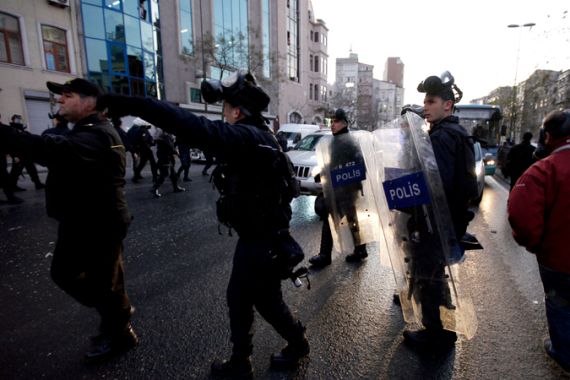Clashes as tensions rise in southeast Turkey
Angry crowds attack local government official a day after 35 Kurdish civilians killed in botched raid are laid to rest.

Angry villagers have attacked a local government official as he attempted to visit districts in southeast Turkey where 35 Kurdish civilians were killed in a botched raid by Turkish military jets.
Nais Yavuz, the deputy governor, was pushed and shoved, and had stones thrown at him during the first official visit to the village of Uludere on Saturday, a day after funerals for the dead civilians had taken place.
Keep reading
list of 4 itemsTurtles swimming to extinction in Malaysia as male hatchlings feel heat
Could shipping containers be the answer to Ghana’s housing crisis?
Thousands protest against over-tourism in Spain’s Canary Islands
As the official tried to escape the angry crowds, people gathered around him chanting slogans against the government, and calling Turkish Prime Minister Recep Tayyip Erdogan a “murderer”.
Meanwhile, the Turkish government promised a full inquiry into Wednesday’s air strikes, which resulted in one of the highest single-day civilian death tolls in the long-standing conflict between the Turkish state and Kurdish rebels, who took up arms in 1984.
‘Detailed investigation’
In the third day of civil unrest, stone-throwing demonstrators clashed with police who fired tear gas and water cannon in several cities in the mostly Kurdish southeast.
Turkish rights groups have called for a UN-sponsored investigation into the strike on the Iraqi border that the government has called an operational mistake.
|
“The incident requires a more detailed investigation, but it is an execution without due process, and carries the characteristics of a mass murder in terms of the number of victims “ – Human Rights Group |
The groups’ preliminary report into Wednesday’s incident says that most of those killed near the border village of Uludere were between the ages of 12 and 18.
Turkish media have reported that 28 out of the 35 dead belonged to the same extended family and carried the same surname.
“The incident requires a more detailed investigation, but it is an execution without due process, and carries the characteristics of a mass murder in terms of the number of victims,” Mazlumder, a rights group, and the Human Rights Association (IHD) said in their report on Friday.
“Turkish and international non-governmental organisations should investigate the incident and the UN Human Rights Committee should send a committee right away.”
The incident, which is under government investigation, has raised tensions with minority Kurds in Turkey, sparking clashes between stone-throwing protesters and police in cities in the mainly pro-Kurdish southeast and areas in Istanbul.
Call for ‘uprisings’
The acknowledgement that the raid had been an error was dismissed by the Kurdistan Workers Party (PKK), a party organised to fight for autonomy in Turkey’s Kurdish-majority southeast which the Turkish government as well as the US and the European Union consider a terrorist organisation.
“This massacre was no accident … It was organised and planned,” Bahoz Erdal from the PKK’s armed wing said in a statement.
|
“The first drone killed 20 people, who were right on the border. We started running towards Iraq, and bombs started to fall on those who were left behind on the rocky area.” – Haci Encu, 19-year-old survivor |
“We urge the people of Kurdistan … to react after this massacre and seek a settling of accounts through uprisings.”
Erdogan admitted earlier on Friday that the victims of the attack were smugglers and not separatist fighters from the PKK as the army had originally claimed.
Smuggling is an important source of income for locals in provinces along the Iraqi border, with many villagers involved in bringing fuel, cigarettes and other goods from Iraqi villages.
PKK fighters also cross the border in these areas.
Speaking in Istanbul, Erdogan voiced his regret for what he called an “unfortunate and distressing” incident.
“Images transmitted by drones showed a group of 40 people in the area; it was impossible to say who they were,” he said.
The military also offered its condolences on Friday in a rare gesture that appeared to acknowledge its error.
Turkish newspapers on Friday carried front-page pictures showing lines of corpses covered by blankets on a barren hillside, with weeping relatives around the bodies.
Survivor’s testimony
In their report, IHD and Mazlumder quoted 19-year-old Haci Encu, who survived the attack and was in hospital, as saying the smugglers were a group of about 40-50 people with mules and were attacked by drones when they were crossing the border to Iraq.
“We were going for sugar and diesel. We even heard the drone, but we kept on walking because it’s our ordinary route,” Encu is quoted as saying.
“The first drone killed 20 people, who were right on the border. We started running towards Iraq, and bombs started to fall on those who were left behind on the rocky area. We were six people in my group, and three of us survived. We had civilian clothes and nobody was armed.
“The attack lasted around an hour. Me and a couple of other people with three mules, we went into a river, waited there for an hour and went out to hide beneath rocks.
“We have been doing this for a long time. Two people from the group were married; the rest were high school and secondary school students. Nobody has contacted me for testimony yet, and I haven’t seen a single soldier since the incident.”